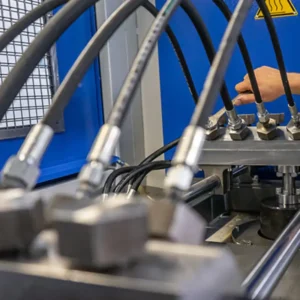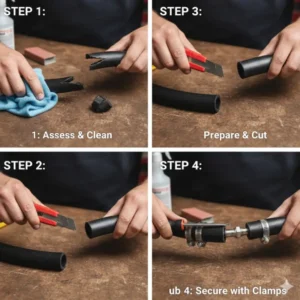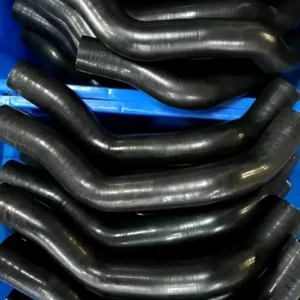When it comes to the power and precision of modern machinery, few components are more crucial than hydraulic hose assemblies. These humble tubes are the lifeblood of hydraulic systems, transporting high-pressure fluids to power everything from heavy excavators to complex industrial robots. But a hydraulic system is only as strong as its weakest link, and that often depends on the quality and integrity of the hose assembly itself.
What Is a Hydraulic Hose Assembly?
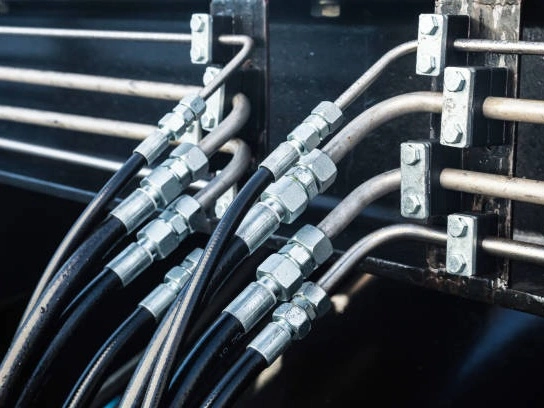
A hydraulic hose assembly is a complete, ready-to-use unit that serves as a flexible fluid conduit in a hydraulic system. It is composed of two primary components: a flexible hydraulic hose and compatible end fittings that have been permanently attached.
This assembly is engineered to safely and efficiently transmit high-pressure hydraulic fluid between system components, such as pumps, valves, cylinders, and motors. Its core function is to facilitate the transfer of fluid power to perform work. Understanding this critical component is essential, as a failed hydraulic hose assembly can lead to system downtime, costly repairs, and significant safety risks. Its integrity is vital for the reliable operation of any hydraulic-powered machinery.
What Are the Parts of a Hydraulic Hose?
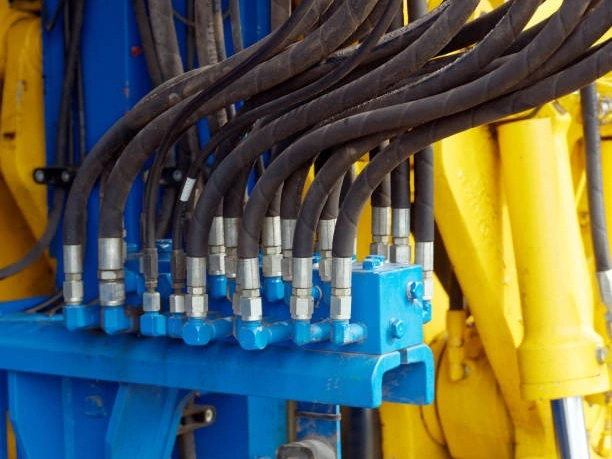
Understanding the construction of a hydraulic hose is crucial for appreciating its function and ensuring proper selection. Each layer plays a vital role in the overall integrity and performance of the hydraulic hose assembly. These layers work in concert to withstand internal pressure, external abrasion, and various environmental conditions. Let’s delve into the four main components that make up a typical hydraulic hose.
Components of a Hydraulic Hose
- Core tube (core tube): This is the innermost layer of the hose and comes into direct contact with the hydraulic fluid. Its primary function is to contain the fluid and ensure chemical compatibility. This material, typically a synthetic rubber or thermoplastic, must be compatible with the specific type of hydraulic fluid used (e.g., mineral, synthetic, or water-based) to prevent degradation, swelling, or contamination.
- Reinforcement Layer(s): This layer is the key to the hose’s strength and gives it its pressure-bearing capacity. It is constructed from one or more layers of braided or spiraled wire (steel or synthetic) or textile fabric. The number and orientation of these layers determine the hose’s operating pressure rating and flexibility.
- Adhesion Layer (Skive/Bonding Layer): This thin layer is usually located between the inner tube and the reinforcement layer, and sometimes between the reinforcement layers. Its purpose is to ensure that the different layers of the hose are effectively bonded together during the manufacturing process and remain firmly connected under pressure and bending.
- Outer Cover: This is the outermost protective layer of the hose. It protects the internal components from external damage caused by abrasion, cuts, impact, weather (UV rays, ozone), chemicals, and oils. It is typically made of a durable synthetic rubber compound designed to withstand the harsh working environments typically encountered by hydraulic hoses.
Assembling Hydraulic Hose
Crafting a reliable hydraulic hose assembly is a meticulous process that requires precision and the right tools. It involves more than simply connecting a hose to two fittings; it’s about creating a secure, leak-proof, and resilient connection that can withstand the intense pressures of hydraulic systems. Here are the key steps we follow to assemble a hydraulic hose.
- Measurement: First, we precisely measure the required length of the hose. We account for factors like the hose’s bending radius, the range of motion of the connected components, and the space needed for fitting engagement to ensure the assembly fits and functions correctly.
- Cutting: We use a specialized hose saw to make a clean, square cut. This prevents the hose from fraying and ensures a proper, secure attachment for the fittings.
- Skiving: Depending on the hose and fitting types, we may need to “skive” the hose. This involves carefully removing the outer cover or inner tube to expose the reinforcement layer, a crucial step for certain crimp styles.
- Fitting Insertion: The correct fittings are then carefully inserted into the prepared hose ends, making sure they are fully seated to the proper depth.
- Crimping: Using a hydraulic crimping machine with the right die set, we apply immense force to compress the fitting onto the hose permanently. After crimping, we check the crimp’s diameter with a caliper to confirm it meets the manufacturer’s specifications.
- Cleaning: We meticulously clean the inside of the finished assembly to remove any debris from the cutting and skiving processes. This prevents contamination of the hydraulic system, which could damage sensitive components.
- Testing: Finally, we pressure-test the completed assembly to its maximum rated working pressure. This final check confirms the assembly’s integrity and ensures it’s leak-free and safe to install.
Assembling Hydraulic Hose Length
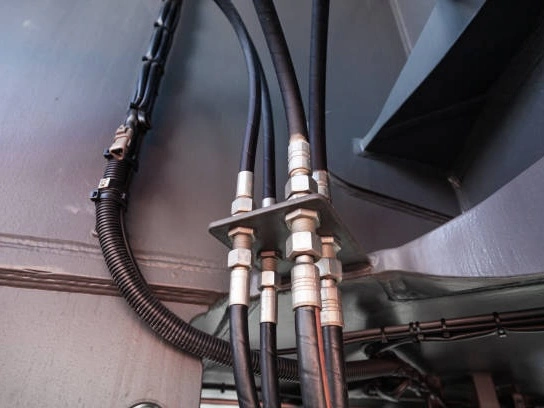
Determining the correct hydraulic hose assembly length is more than just measuring the straight-line distance between two points. It’s a critical factor that influences system performance, hose lifespan, and safety. An assembly that is too short can lead to excessive tension, restricted movement, and premature failure, while one that is too long can create clutter, abrasion points, and inefficient fluid flow.
Factors for Determining Length
- Movement: Consider the full range of movement of the hose’s connected parts. The hose should be long enough to accommodate this movement without stretching or kinking.
- Flexing: Hydraulic hoses are designed to be flexible. Sufficient length should be provided to allow the hose to bend naturally and absorb vibrations.
- System Pressure: Hoses can slightly change length under pressure. Allow for this minor expansion or contraction.
- Routing: Consider obstacles, sharp edges, and potential abrasion points. Proper routing might require additional length to avoid these hazards.
- Minimum Bend Radius: Never bend a hose tighter than its specified minimum bend radius. Extra length may be needed to achieve a gentle, compliant bend.
- Hose Layline: When measuring, ensure the hose’s layline (a stripe running along its length) remains straight, indicating no twisting, which can significantly reduce hose life.
A general rule of thumb is to add a small amount of extra length beyond the direct measurement to allow for these factors, ensuring the hose can perform optimally without undue stress.
Assembling Hydraulic Hose Tips
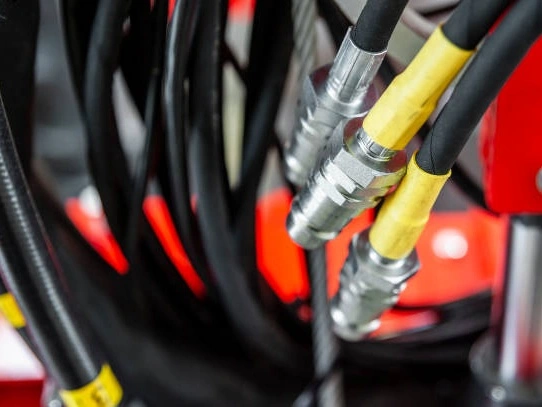
When we work with hydraulic hose assembly, following best practices is key to ensuring longevity and reliable performance. A few simple tips during handling and installation can significantly extend the service life and prevent unexpected failures.
- Avoid Twisting: Never install a hose in a twisted state. Twisting can drastically reduce a hose’s life, sometimes by as much as 70%. Always ensure the hose’s layline (the stripe running along its length) remains straight, confirming a proper, untwisted installation.
- Respect the Bend Radius: Every hose has a minimum bend radius. Bending a hose tighter than this specification puts immense stress on its layers, leading to premature fatigue and potential failure.
- Protect from Abrasion: Route hoses away from sharp edges, hot surfaces, and any other components they might rub against. If contact is unavoidable, use protective hose sleeves or spiral wrap to shield the hose.
- Prevent Kinking: Ensure the hose has enough slack to move freely without kinking. Kinks restrict fluid flow and damage the internal structure, compromising the hose’s integrity.
- Cleanliness is Crucial: Always ensure fittings and hose ends are clean before assembly and installation. Contaminants can damage sensitive system components, leading to expensive repairs and downtime.
Clean Hydraulic Hose Assemblies
Cleanliness in a hydraulic hose assembly is crucial for your system’s health. Microscopic contaminants can cause significant damage to pumps and valves, leading to premature wear and failure. That’s why cleaning new assemblies before installation isn’t just a suggestion—it’s a critical best practice.
- Why it’s important: Contaminants from cutting or assembly can circulate and damage precision components, shorten fluid life, and reduce system efficiency.
- Effective cleaning methods: The most effective method is projectile cleaning, where a foam or rubber projectile is forced through the hose with compressed air to remove debris. Other methods include flushing with a compatible fluid or blowing air through the hose, though they may not be as thorough.
- Final Step: Always cap both ends of the clean assembly immediately to prevent re-contamination before installation. This simple step ensures the integrity of your entire system.
Replacing Hydraulic Hose Assembly
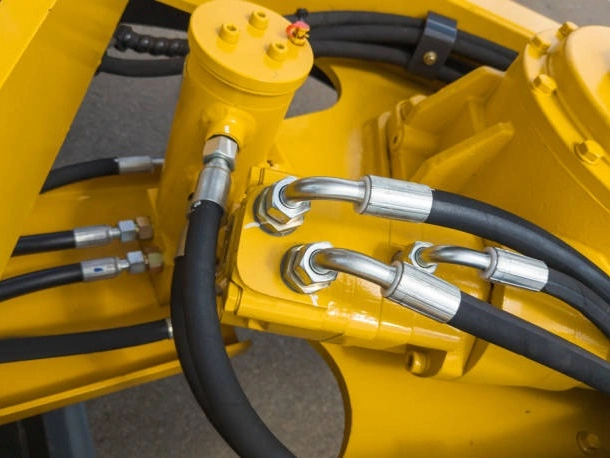
Regularly replacing hydraulic hose assemblies is a key part of proactive maintenance. Waiting for a catastrophic failure can lead to dangerous situations, expensive downtime, and costly repairs. Timely replacement, based on routine inspections, is crucial for maintaining a safe and efficient system.
- Visible Damage: Immediately replace any hose with cuts, cracks, blisters, severe abrasion, or exposed wire reinforcement.
- Leaks: Even minor drips are a sign of a compromised hose and require prompt attention.
- Kinking or Crushing: A hose that has been kinked or crushed has irreversible internal damage that compromises its pressure rating.
- Hardening or Brittleness: Over time, exposure to heat and chemicals can cause the hose material to become brittle.
- Age: Hoses degrade with age. Many manufacturers recommend replacing hoses every 5-7 years, regardless of their appearance.
- Performance Issues: Unexplained drops in pressure or sluggish system performance can sometimes point to internal hose damage or blockage.
Conclusion
Hydraulic hose assemblies are essential yet often overlooked components across countless industries, from construction and agriculture to manufacturing and transportation. Investing in high-quality components and following hydraulic hose assembly best practices isn’t just about preventing downtime; it’s about protecting personnel, optimizing performance, and ensuring the long-term success of our valuable machinery.

